User:Rursus/Large Magellanic Cloud
(Place for a rework of Large Magellanic Cloud ― please regard this page as an article space, where mistakes and sketches are allowed. Discuss on the talk page.)
(intro)
History
[edit]Geometry
[edit]Distance
[edit]Features
[edit]X-ray sources
[edit]View from the LMC
[edit]Gallery
[edit]This section contains an unencyclopedic or excessive gallery of images. |
-
SNR B0544-6910 in the LMC. Credit: ESO
-
SNR 0543-689 in the LMC. Credit: ESO
-
N44 region in the Large Magellanic Cloud. Credit: ESO
-
DEM L 159 and two clusters KMHK 840 (top left) and KMHK 831 (bottom right). Credit: ESO
See also
[edit]Notes
[edit]Further reading
[edit]- "Single measurement throws out everything we thought we knew". physorg.com, September 17, 2007.
External links
[edit]
New sources found, dot points
[edit]Henbest, Nigel (1990-02-24), "Portrait of an exploding star: Exactly three years ago, a star blew itself apart in a nearby galaxy. Astronomers have now laid bare the details of the explosion", New Scientist (1705){{citation}}: CS1 maint: date and year (link)
- Supernova SN1987A happened in the LMC
- first supernova for almost 400 years to be visible to the naked eye
Gendler, Robert (2006). A Year in the Life of the Universe: A Seasonal Guide to Viewing the Cosmos. USA: Voyageur Press. p. 58. ISBN 07603-2642-8. {{cite book}}: Unknown parameter |coauthors= ignored (|author= suggested) (help)
- LMC is a dwarf irregular galaxy
- 20,000 light-years across
- 4th largest member of the Local Group
- Named after Ferdinand Magellan, who noted it in 1519
- Contains, among other things:
- diverse population of young stars
- HII regions
- 30 Doradus
- indications of encounters with the Milky Way such as warps, rings and tidal distortions
Freeman, Ken (2006). In Search of Dark Matter. Springer. p. 58. ISBN 0-387-27616-5. {{cite book}}: Unknown parameter |coauthors= ignored (|author= suggested) (help)
- LMC probably contains dark matter
- Flat rotation curve
- LMC is "disorganized and messy"
- Rotation is disturbed
- Contained within the dark matter halo of the Milky Way
Malin, David (1995). Hartung's astronomical objects for southern telescopes: a handbook for amateur observers. New York: University of Cambridge. p. 278. ISBN 0-521-55491-8. {{cite book}}: Unknown parameter |coauthors= ignored (|author= suggested) (help)
- Lies in Dorado and Mensa
- Visible as a large hazy region in the southern sky
- Due to its proximity, a better study can be made of its interior than any other galaxy outside our own
- Contains open clusters and globular clusters
Block, David (2008). Shrouds of the night: masks of the Milky Way and our awesome new view of galaxies. New York: Springer. p. 323. doi:10.1007/978-0-387-78975-0. ISBN 978-0-387-78974-3. {{cite book}}: Unknown parameter |coauthors= ignored (|author= suggested) (help)
- Contains a small, off-center, bar
- Prominent northern arm
- Two small southern arms
- Prevailing view before 1950 was that LMC is irregular
- Gerard de Vaucouleurs demonstrated spiral nature with photographic plates he recorded from 1952–1955
- H C Russell claimed spiral structure in 1890
Henbest, Nigel (2996). The new astronomy. New York: University of Cambridge. p. 146. ISBN 978-0-521-40324-5. {{cite book}}: Check date values in: |date= (help); Unknown parameter |coauthors= ignored (|author= suggested) (help)
- Easily visible to the naked eye
- Receding from the Milky Way
- Contains one twentieth as many stars as MW
- Analogous to our galaxy in many ways
- Easy to study because it is obvious where the components are relative to each other
- Bar consists mostly of old stars, but some young ones are present
Struve, Otto (1959). Elementary Astronomy. New York: Oxford University Press. p. 246. {{cite book}}: Unknown parameter |coauthors= ignored (|author= suggested) (help)
- Receding at 276 kilometres per second (171 mi/s)
Long, K. S.; Helfand, D. J.; Grabelsky, D. A. (09/1981). "A soft X-ray study of the Large Magellanic Cloud" (PDF). Astrophysical Journal. 248 (1): 925–944. Bibcode:1981ApJ...248..925L. doi:10.1086/159222. Retrieved 2010-03-06. {{cite journal}}: Check date values in: |date= (help)
- The spiral arms comprise the Pop I stars
- The bar consists of low mas Pop II stars
- Between 5% and 9% of the LMC is composed of atomic hydrogen
- Lies 30° out of the galactic plane
- Reduces absorption by Galactic gas
van der Marel, Roeland P. (October 2001). "Magellanic Cloud Structure from Near–Infrared Surveys I. The Viewing Angles of the Large Magellanic Cloud" (PDF). The Astronomical Journal. 122 (4): 1807–1826. doi:10.1086/323099. Retrieved 2010-03-07. {{cite journal}}: Unknown parameter |coauthors= ignored (|author= suggested) (help)
- Inclined 34.7° +- 6.2°
- Disk may be warped
- Line of nodes 122.5° +- 8.3°
- Important in determining the cosmological distance scale
- Used to study the presence of dark objects in the Milky Way's halo through microlensing
Images
[edit]- NasaImages.org: Our Chaotic Neighbor/LMC, LMC portrait in IR.






